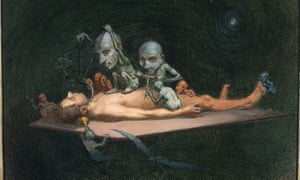The Wellcome Collection’s new exhibition States of Mind uses science and art to unravel mysteries from memory loss to sleepwalking
On a crumpled sheet of tin foil in the Wellcome Collection’s conservation studio lies an odd assortment of plasticine forms. One looks suspiciously like the footprint of a chicken, another like a deformed pot, while a large, red lump bears more than a passing resemblance to a gammon joint. But the comparisons are hopelessly wide of the mark. For these are, in fact, part of a determined effort by a great scientist to explore one of the most curious facets of being: consciousness. Yet while Francis Crick revealed the hidden secrets of DNA through a model, his attempts at applying similar techniques to neuroanatomy in an exploration of our inner sense of “self” were less successful. “We brought a couple of neuroscientists in to look at them and bafflement was the result of that encounter too,” admits Emily Sargent, curator of the Wellcome Collection’s latest exhibition States of Mind: Tracing the Edges of Consciousness. Nevertheless Crick’s wide-ranging work in the field was influential, not least in breaking the taboo of tackling the topic in scientific circles.
Although Crick was pivotal in bringing the study of consciousness into the scientific arena, he wasn’t the only one to be captivated by its mysteries. From Descartes on the separation of mind and body to modern musings on whether consciousness is an illusion, many have struggled to tease the phenomenon apart. Yet progress is being made. “I think we understand a lot more about what makes us conscious and what we are conscious of, but we still don’t really know how consciousness happens at the deepest levels of explanation,” says the exhibition’s scientific adviser, Professor Anil Seth. “It is still a bit of a mystery.”
Forming the second part of the Wellcome Collection’s foray into consciousness, the exhibition will put experience at its heart. “The understanding of consciousness is one thing but the experience is something that we can all grasp,” says Sargent. Split into four sections, and boasting an installation space featuring a changing array of works, the exhibition will bring together Crick’s models and annotated papers (under the label of Science|Soul) and a broad collection of images, artworks and artefacts to probe the elusive, beguiling and sometimes alarming experiences linked to our inner lives.
And it’s personal. “Language and memory are critical tools of this idea of a conscious self — the ‘I’ behind these subjective experiences,” says Sargent. Kicking off the exhibition, visitors will be asked to recall their earliest memory – and reveal how old they were when the event occurred. The results will be collected and displayed on a huge wallchart while it is planned that the memories themselves will be recorded in an audio format. “Later in the exhibition [the artist] AR Hopwood has been looking at false memory and how often some of these memories are vulnerable to a kind of distortion or reworking as we continue to recall them,” Sargent adds, although she is quick to point out: “It is not about robbing people of treasured memories but rethinking our relationship with things like memory.”
Also within Language|Memory artist Shona Illingworth, who has been working with an amnesiac named Claire, together with scientists Professor Martin Conway and Dr Catherine Loveday, explores memory loss, from its impact on identity to its effect on the ability to explore one’s past and imagine the future. Among the pieces on show will be footage taken by Claire’s automatic “SenseCam” during a visit to the Scottish archipelago of St Kilda, whose last 36 residents were evacuated in 1930. “For Claire the majority of her past is told by other people and that is similar for St Kilda in that the majority of accounts of it have been written by people who were not part of that cultural presence there,” says Illingworth.
It’s not the only work that invites compassion as well as curiosity. Included under the banner of Being|Not Being are two documentary films by Israeli artist Aya Ben-Ron, the first of which records the moment when patients go under general anaesthetic. “You can see there that the doctors treat them differently when they are awake and asleep,” she says. Her second looks at the lives of those in a permanent vegetative state. “It is a film about moral issues, it is about caring and humanity and what is the value of life,” she says.
Sleep|Awake explores a very different set of experiences, including sleep paralysis, in which an individual is awake, yet unable to move. Among the works featured will be first-person accounts as well as images such as The Nightmare by Henry Fuseli which, says Sargent, could well have been inspired by such reports. Sleepwalking, too, is explored in many forms, including the eerie reclining figure of Goshka Macuga’s Somnambulist, inspired by a character from the 1920 horror filmThe Cabinet of Dr Caligari, also on show. Most intriguing of all is the promise of newspaper clippings relating to two murder trials in which sleepwalking was used successfully as a defence.
Seth hopes the exhibition will fill visitors with a sense of wonder. “I want people to leave the room thinking: ‘That’s amazing. All this stuff happening inside my head and my body – that makes me who I am.’”
States of Mind: Tracing the Edges of Consciousness opens on 4 Feb

No comments:
Post a Comment